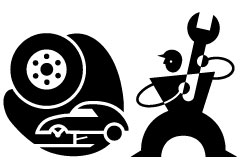Basic Car Maintenance on Sunday - Vol.99
Your car is something you can trust with some of the most important tasks over the week. It carries you all the way from home to work and back again. It accompanies you to the mart and returns home laden with bags of groceries. It transforms into an utterly romantic ride or a complete family car as required, and it endures your pets and kids with more patience than we humans can ever imagine.

In return for these favors, all we want for our car is to keep running in the same manner for infinite weeks to come. This is the reason that your car demands at least one day out of your busy schedule for the care and concern it deserves. It has to be Sunday.
Don't worry, we are not asking you to spend your Sundays with your mechanic. As a matter of fact, we are here to share with you some DIY car maintenance tips that will ensure a healthy running car you can trust all week.
Check Engine Oil and Coolant
Car engine oil is just like blood in your car. You have to maintain a certain level. It ensures that every part of the engine is running smoothly without much heating and wear. It is very important to check the engine oil level as it tends to drop every time you drive. The procedure is pretty simple and straightforward.
To do it like a pro, it is best to park your car on a level surface. The engine must be allowed to cool down for a few minutes. Now lift the hood, look for the dipstick, remove it and wipe it clean to see the marks on it clearly. Now insert the dipstick back and take it out again. Check the oil level according to the markings. It should be somewhere between the highest and lowest level markings, closer to the former.
If the level is below the low level mark, it is generally advisable to pour half a liter oil to bring it up to the required level. It is best to pour it in two takes in order to avoid overfill.
Engine coolant and transmission fluids can also be checked in the same manner. Use your car manual to locate the coolant and ATF reservoirs.
Check Tires and Treads
Every car has a different tire pressure recommended by the manufacturer. If the pressure is lower or higher than the recommended limit, it can cause other problems that hinder the driving experience and may cause accidents. Better safe than sorry - buy a gauge and dedicate a few minutes out of your weekend to your car tires.
Your car must be standing still for around an hour or so before you can check the pressure. Remove the dust-cap and place the gauge on the valve. Check the reading and see if it is higher or lower than the recommended pressure. If the pressure is lower, inflate it accordingly.
Also, check for wear and tear on the treads. Tires with extremely worn out tread can be critically dangerous for you and other drivers on the road.
Battery Terminals and Lights
Battery is a very important component of your car. If you are trying to tinker with any electronic aspect of your car, make sure you have disconnected the battery. Anyhow, you should also keep the battery terminals clean in order to allow proper amount of current to pass around the system. You can simple remove the terminal caps, negative first.
Make sure the terminals are not corroded heavily. Also, keep an eye for cracks or leaks in the battery clean each terminal cap and contact post with a wire brush and reattach them, positive first this time.
Lights are fairly easier to remove and replace. Make sure the bulbs are neither too dim nor too bright. Park your car facing a wall and keep the lights on. Cheek if the light falls well within the desired distance. When replacing the bulb, avoid leaving any traces of grease and oil on the glass. It can cause that specific area to heat up and crack.